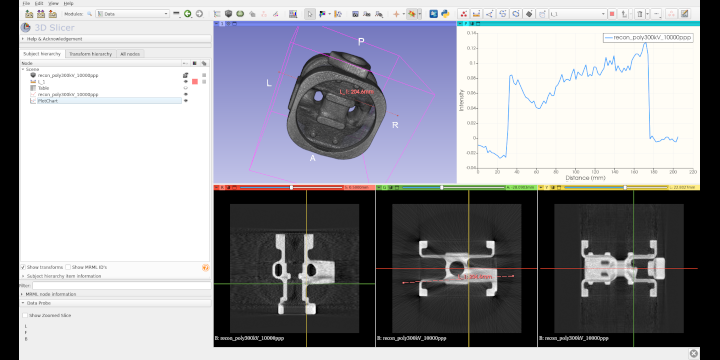Teaching XCT in NDT using Simulation on GPU with gVirtualXray
Written by: Jean Michel Létang and Franck P. Vidal Published on:
Published on: Summary
We have deployed gVXR in material science lab-sessions delivered to about 150 MEng students a year at the INSA-Lyon and Polytech Lyon 1 engineer schools.
It has been embedded in a Jupyter notebook together with the open-source reconstruction toolkit RTK. Several interactive exercises have been proposed to enable students to learn and gain hands-on experience with X-ray tomographic setups. They first study both digitally with the twin and experimentally with the bench the critical sensibility to crack orientation in a cylindrical sample (additive manufacturing) in which a through crack has been added.
Then the students gradually familiarize themselves with the 3D reconstruction technique: (i) first with mono-energy and no noise (i.e. infinite stat), then (ii) with a given exposure (i.e. number of X-rays per pixel) to highlight photon starvation, and (iii) finally with a realistic energy distribution typical of an X-ray generator to understand beam hardening.
An example of the 3D visualization of the reconstructed simulated volume is shown in the figure above.
It is worth noting that this progression in the complexity of the imaging setup cannot be done experimentally with such cohort sizes. The digital twinning of the X-ray setup is crucial for those lab sessions of the material science department.
Award
Best paper award for tomography outreach tools - Vidal, F. P., Afshari, S., Ahmed, S., Atkins, C., Béchet, É., Corbí Bellot, A., ... Tugwell-Allsup, J. (2024). Müller, B., & Wang, G. (Eds.). "X-ray simulations with gVXR as a useful tool for education, data analysis, set-up of CT scans, and scanner development". Developments in X-Ray Tomography XV, SPIE Optics & Photonics 2024. DOI: 10.1117/12.3025315
Publication
- Vidal, F. P. et al (2024, Nov). X-ray simulations with gVXR as a useful tool for education, data analysis, set-up of CT scans, and scanner development. Developments in X-Ray Tomography XV, SPIE Optics & Photonics 2024. doi:10.1117/12.3025315 .
Citation
@inproceedings{Vidal2024SPIE,
author = {Franck P. Vidal and Shaghayegh Afshari and Sharif Ahmed and
Carolyn Atkins and {\'E}ric B{\'e}chet and Alberto Corb{\'i} Bellot and
Stefan Bosse and Younes Chahid and Cheng-Ying Chou and Robert Culver and
Lewis Dixon and Johan Friemann and Amin Garbout and Cl{\'e}mentine Hatton and
Audrey Henry and Christophe Leblanc and Alberto Leonardi and
Jean Michel L{\'e}tang and Harry Lipscom and Tristan Manchester and
Bas Meere and Simon Middleburgh and Iwan Mitchell and Liam Perera and
Mart{\'i} Puig and Jenna Tugwell-Allsup},
title = {{X-ray simulations with gVXR as a useful tool for education,
data analysis, set-up of CT scans, and scanner development}},
volume = {13152},
booktitle = {Developments in X-Ray Tomography XV},
editor = {Bert M{\"u}ller and Ge Wang},
organization = {International Society for Optics and Photonics},
publisher = {SPIE},
pages = {131520W},
keywords = {X-ray imaging, Computed tomography (CT), Simulation,
Digital twinning, Graphics processor unit (GPU) programming,
Image registration, Digitally reconstructed radiograph (DRR),
Machine learning},
year = {2024},
doi = {10.1117/12.3025315},
}